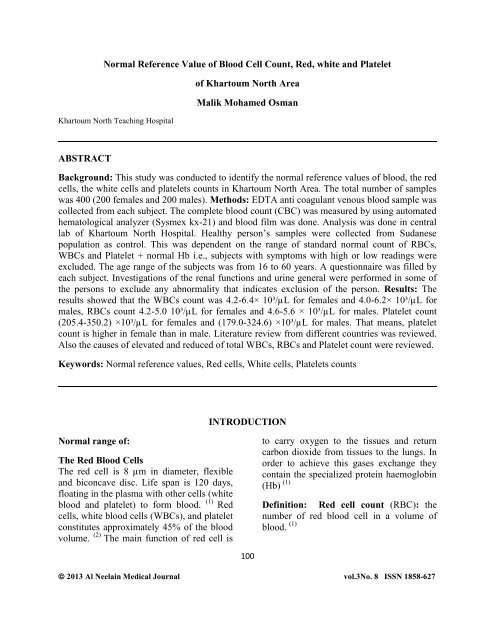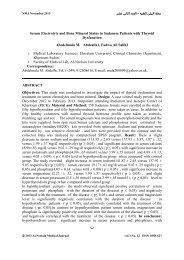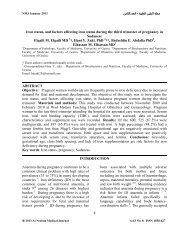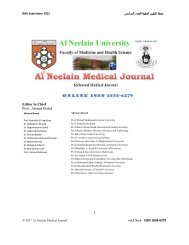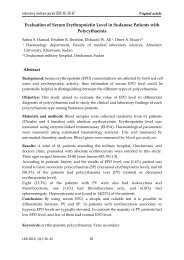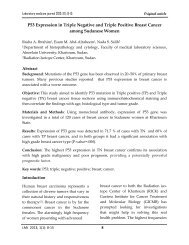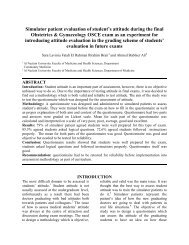Normal Reference Value of Blood Cell Count, Red, white and ...
Normal Reference Value of Blood Cell Count, Red, white and ...
Normal Reference Value of Blood Cell Count, Red, white and ...
Create successful ePaper yourself
Turn your PDF publications into a flip-book with our unique Google optimized e-Paper software.
<strong>Normal</strong> <strong>Reference</strong> <strong>Value</strong> <strong>of</strong> <strong>Blood</strong> <strong>Cell</strong> <strong>Count</strong>, <strong>Red</strong>, <strong>white</strong> <strong>and</strong> Platelet<br />
<strong>of</strong> Khartoum North Area<br />
Malik Mohamed Osman<br />
Khartoum North Teaching Hospital<br />
ABSTRACT<br />
Background: This study was conducted to identify the normal reference values <strong>of</strong> blood, the red<br />
cells, the <strong>white</strong> cells <strong>and</strong> platelets counts in Khartoum North Area. The total number <strong>of</strong> samples<br />
was 400 (200 females <strong>and</strong> 200 males). Methods: EDTA anti coagulant venous blood sample was<br />
collected from each subject. The complete blood count (CBC) was measured by using automated<br />
hematological analyzer (Sysmex kx-21) <strong>and</strong> blood film was done. Analysis was done in central<br />
lab <strong>of</strong> Khartoum North Hospital. Healthy person’s samples were collected from Sudanese<br />
population as control. This was dependent on the range <strong>of</strong> st<strong>and</strong>ard normal count <strong>of</strong> RBCs,<br />
WBCs <strong>and</strong> Platelet + normal Hb i.e., subjects with symptoms with high or low readings were<br />
excluded. The age range <strong>of</strong> the subjects was from 16 to 60 years. A questionnaire was filled by<br />
each subject. Investigations <strong>of</strong> the renal functions <strong>and</strong> urine general were performed in some <strong>of</strong><br />
the persons to exclude any abnormality that indicates exclusion <strong>of</strong> the person. Results: The<br />
results showed that the WBCs count was 4.2-6.4× 10³/µL for females <strong>and</strong> 4.0-6.2× 10³/µL for<br />
males, RBCs count 4.2-5.0 10³/µL for females <strong>and</strong> 4.6-5.6 × 10³/µL for males. Platelet count<br />
(205.4-350.2) ×10³/µL for females <strong>and</strong> (179.0-324.6) ×10³/µL for males. That means, platelet<br />
count is higher in female than in male. Literature review from different countries was reviewed.<br />
Also the causes <strong>of</strong> elevated <strong>and</strong> reduced <strong>of</strong> total WBCs, RBCs <strong>and</strong> Platelet count were reviewed.<br />
Keywords: <strong>Normal</strong> reference values, <strong>Red</strong> cells, White cells, Platelets counts<br />
INTRODUCTION<br />
<strong>Normal</strong> range <strong>of</strong>:<br />
The <strong>Red</strong> <strong>Blood</strong> <strong>Cell</strong>s<br />
The red cell is 8 µm in diameter, flexible<br />
<strong>and</strong> biconcave disc. Life span is 120 days,<br />
floating in the plasma with other cells (<strong>white</strong><br />
blood <strong>and</strong> platelet) to form blood. (1) <strong>Red</strong><br />
cells, <strong>white</strong> blood cells (WBCs), <strong>and</strong> platelet<br />
constitutes approximately 45% <strong>of</strong> the blood<br />
volume. (2) The main function <strong>of</strong> red cell is<br />
to carry oxygen to the tissues <strong>and</strong> return<br />
carbon dioxide from tissues to the lungs. In<br />
order to achieve this gases exchange they<br />
contain the specialized protein haemoglobin<br />
(Hb) (1)<br />
Definition: <strong>Red</strong> cell count (RBC): the<br />
number <strong>of</strong> red blood cell in a volume <strong>of</strong><br />
blood. (1)<br />
100<br />
2013 Al Neelain Medical Journal vol.3No. 8 ISSN 1858-627
<strong>Normal</strong> range <strong>of</strong> <strong>Red</strong> cells count in<br />
British population:<br />
Man 5.0±0.5×10 6 /µL. Women 4.3±<br />
0.5×10 6 /µL<br />
Hb: Man 15.0±1.5 gm/d L. Women<br />
13.5±2 gm/d L (3)<br />
<strong>Normal</strong> range varies slightly between<br />
laboratory but is generally between (4.2-<br />
5.9) million cells/cm.sq. (4) High red blood<br />
cell count have a variety <strong>of</strong> causes, some <strong>of</strong><br />
which can be quite serious, including heart,<br />
lung, <strong>and</strong> kidney disease. Polycythemia<br />
Vera, a bone marrow disorder, is another<br />
cause. (5)<br />
White blood cell<br />
White <strong>Blood</strong> <strong>Cell</strong>s are an important part <strong>of</strong><br />
the body’s defence system. But too much is<br />
not always good. (11)<br />
White <strong>Blood</strong> <strong>Cell</strong>s definition:<br />
Are mainly concerned with protecting the<br />
body against invasion by micro organisms. (2)<br />
White blood cells, also called leukocytes,<br />
help the body fight infection. (12) .<br />
White <strong>Blood</strong> <strong>Cell</strong> <strong>Count</strong> <strong>and</strong> CBC<br />
<strong>Blood</strong> circulate through the body providing<br />
nutrients <strong>and</strong> oxygen to all the cells in the<br />
body <strong>and</strong> similarly remove the waste<br />
products. When you go in for a complete<br />
physical test, you will probably undergo a<br />
series <strong>of</strong> tests to evaluate the composition<br />
<strong>and</strong> concentration <strong>of</strong> all the cellular<br />
components <strong>of</strong> blood. This test is known as<br />
the Complete <strong>Blood</strong> <strong>Count</strong> (CBC) <strong>and</strong><br />
consists <strong>of</strong> tests to evaluate <strong>Red</strong> <strong>Blood</strong> <strong>Cell</strong><br />
(RBC) count, White <strong>Blood</strong> <strong>Cell</strong> (WBC)<br />
count, the platelet count, <strong>and</strong> measurement<br />
<strong>of</strong> hemoglobin, mean red cell volume <strong>and</strong> a<br />
few more. (11) The Complete <strong>Blood</strong> <strong>Count</strong><br />
helps evaluate the blood <strong>and</strong> the bone<br />
101<br />
marrow <strong>and</strong> is usually performed to ensure<br />
oxygen carrying capacity <strong>of</strong> the blood,<br />
identify infections, diagnose anemia <strong>and</strong><br />
leukemia <strong>and</strong> also gauge the effect <strong>of</strong><br />
chemotherapy <strong>and</strong> radiation therapy on<br />
blood production cells. (11)<br />
Neutrophils: 50 – 70%<br />
Lymphocytes: 25 – 35%<br />
Basophils: 0.4 – 1%<br />
Eosinophils: 1 – 3%<br />
Monocytes: 4 – 6%<br />
A high blood count (above 30000 cells per<br />
micro-liter) indicates is not a specific<br />
disease by itself but indicates infection,<br />
systemic illness, inflammation, allergy,<br />
leukemia <strong>and</strong> tissue injury caused due to<br />
burns. The count <strong>of</strong> <strong>white</strong> blood cells also<br />
decreases when certain medicines cause<br />
marrow failure. A severely low <strong>white</strong> blood<br />
count i.e. a count less than 2500 cells per<br />
micro-liter is a cause for a critical alert <strong>and</strong><br />
(11)<br />
poses a high risk <strong>of</strong> sepsis.<br />
The platelets: Definition <strong>of</strong> platelet: are<br />
tiny cells which play essential part in the<br />
very complex process <strong>of</strong> blood clotting. A<br />
blood clot a plug” it prevents excessive loss<br />
<strong>of</strong> blood. (1)<br />
The Platelet are fragments are<br />
fragments <strong>of</strong> the <strong>of</strong> the cytoplasm <strong>of</strong> the<br />
megakryocyte; hence they are non-nucleated<br />
<strong>and</strong> formed chiefly in the bone marrow . (19)<br />
Platelet lives only about 10 days, your body<br />
continually renews your platelet supply by<br />
producing new platelets in your bone<br />
marrow. (20)<br />
Platelets made in the bone marrow circulate<br />
for approximately 10 days before removal<br />
from circulate. (21)<br />
2013 Al Neelain Medical Journal vol.3No. 8 ISSN 1858-627
High Platelets is a condition in which <strong>Count</strong>s by automated haematology<br />
the blood contains more platelets than analyzer in different countries<br />
normal. Platelets are small blood cell<br />
fragments that assist in blood clotting. In a Erythrocyte reference values in<br />
healthy person, there are usually 150,000 to<br />
Emirati people was found as<br />
450,000 platelets per micro liter <strong>of</strong> blood. A<br />
follows:<br />
high platelet count can be identified through<br />
Male: 4.5-6.7×10 6 /µL<br />
routine blood tests. (22)<br />
Female: 4.0-5.9×10 6 /µL (82)<br />
The occurrence <strong>of</strong> high platelets is<br />
divided into two medical conditions: And in Togo the Western African<br />
primary thrombocythemia <strong>and</strong> secondary<br />
<strong>Count</strong>ry:<br />
thrombocytosis. In primary<br />
WBC : 4.5×10 9 /L in males<br />
thrombocythemia, the cause <strong>of</strong> the high <strong>and</strong> 5.0×10 9 /L in females.<br />
platelets is not known, <strong>and</strong> it occurs as an<br />
Platelet: 236×10 9 /L in males<br />
independent condition.<br />
<strong>and</strong> 247×10 9 /L in females. (89)<br />
In secondary thrombocytosis, high<br />
platelets occurs as a symptom <strong>of</strong> another In Peninsula (South Africa) Black<br />
disease or condition, such as anemia,<br />
Africans aged 15-64 years (n = 819)<br />
infection or cancer. (22)<br />
aged 15-64 years, reference values<br />
based on the 95% reference limits<br />
Causes <strong>of</strong> Thrombocytopenia:<br />
<strong>of</strong> the haematological parameters:<br />
In general, a low platelet count occurs<br />
(Hb) in men 14.0 g/dl <strong>and</strong> women 12.4 g/dl<br />
because:<br />
World Health Organization’s Hb (< 13 g/dl<br />
men; < 12 g/dl women),<br />
• The bone marrow doesn’t make<br />
enough platelets.<br />
No significant differences were noted in<br />
• The bone marrow makes enough mean total <strong>and</strong> differential <strong>white</strong> blood cell<br />
platelets, but the body destroys them counts (WBC) between men <strong>and</strong> women. (31)<br />
or uses them up.<br />
British population: <strong>Red</strong> cell counts:<br />
The spleen holds on to too many<br />
platelets. . (7)<br />
Man<br />
5.0±0.5×10 6 /µL<br />
A combination <strong>of</strong> the above factors also may<br />
Women<br />
cause a low platelet count. (7)<br />
102<br />
4.3± 0.5×10 6 /µL (3)<br />
U S A: White blood cells count in U<br />
S A varies between 4000-10000 per<br />
micro liter (34)<br />
2013 Al Neelain Medical Journal vol.3No. 8 ISSN 1858-627
OBJECTIVES<br />
General objective:<br />
To determine the normal hematological<br />
parameters in the population <strong>of</strong> Khartoum<br />
north (K.N).<br />
Specific objective:<br />
To determine the normal count <strong>of</strong><br />
RBCs, WBCs <strong>and</strong> platelets in<br />
Sudanese population in Khartoum<br />
north (K.N) .<br />
To to find out (detect or discover)<br />
causes <strong>of</strong> abnormal count.<br />
To make sure <strong>of</strong> known causes <strong>of</strong><br />
abnormal cells, <strong>and</strong> to observe known<br />
<strong>and</strong> unknown relation between red<br />
cells, WBCs <strong>and</strong> platelet count to<br />
facilitate diagnosis <strong>of</strong> disease.<br />
To in abnormal count, I will effort to<br />
find information <strong>of</strong> patients to find<br />
out if there is any relation between<br />
case <strong>and</strong> (diet intake, work, habit,<br />
invironment, live …etc).<br />
To add benefits to science, that<br />
because red cells covering all anemia<br />
<strong>and</strong> more disease when link with the<br />
others cells (WBCs, platelets)<br />
To find out if there is a different in<br />
count with British population, Arab,<br />
European, Indian, African <strong>and</strong><br />
Chinese or as the same.<br />
MATERIALS AND METHODS<br />
Study area: Khartoum North Area.<br />
Analalysis was done in central lab <strong>of</strong><br />
Khartoum North Hospital.<br />
Sample size population:<br />
Total number samples were 400(200 female<br />
<strong>and</strong> 200 male)<br />
Sample population:<br />
-Sample which out <strong>of</strong> the normal range, was<br />
excluded.<br />
-Samples were collected from persons aged<br />
from (16-60) years<br />
Questionnaires were fulfilled. Also renal<br />
function test <strong>and</strong> urine general if needed; to<br />
exclude <strong>of</strong> any person with unfit or with<br />
disease.<br />
Healthy person’s samples were collected<br />
from sundaes population.<br />
Selection criteria:<br />
-Dependent on the range <strong>of</strong> st<strong>and</strong>ard normal<br />
count <strong>of</strong> RBCs, WBCs <strong>and</strong> Platelet + normal<br />
Hb.<br />
Sample technique:<br />
EDTA anti coagulant venous blood samples<br />
was collected. EDTA powerful<br />
103<br />
2013 Al Neelain Medical Journal vol.3No. 8 ISSN 1858-627
anticoagulant acts by its chelating effect on<br />
the calcium molecules in blood. (37).<br />
The complete blood count (CBC) was<br />
measured by using automated<br />
haematological analyzer (Sysmex kx-21)<br />
<strong>and</strong> thin blood film was done. Stain with<br />
Leishmn’s stain.<br />
The Sysmex kx-21 is an automatic multi<br />
parameter<br />
<strong>Blood</strong> cells counter for in vitro diagnostic<br />
used in clinical laboratories.<br />
The kx-21 performs speedly <strong>and</strong> accurate<br />
analysis <strong>of</strong> 18 parameters in<br />
Pre diluted mode: this mode is used in<br />
analyzing a minute amount <strong>of</strong> child, s blood,<br />
for instance, collected from the ear lobe or<br />
finger tip. In this mode, blood sample<br />
diluted into 1:26 before analysis is used. The<br />
sample aspiration procedure is the same as<br />
in the whole blood mode. (38)<br />
Ethical Clearance: Was obtained from<br />
Health Authorities in Khartoum North<br />
The kx-21 process approximately 60<br />
samples an hour.<br />
RESULTS<br />
The study shows <strong>Normal</strong> results <strong>of</strong> mean ± st<strong>and</strong>ard deviation as follows:<br />
TWBCs<br />
(5.3 ± 1.1) ×10³/µL in females<br />
TWBCs<br />
(5.1 ± 1.1) ×10³/µL in males<br />
RBCs<br />
(4.6 ± 0.4) × 10 6 /µL in females<br />
(4.6 ± 0.4) million/ μL in females<br />
RBCs<br />
(5.1 ± 0.5) ×10 6 /µL in males<br />
(5.1 ± 0.5) million/ μL in males<br />
Platelet<br />
(277.8±72.4) ×10³/µL in females<br />
104<br />
2013 Al Neelain Medical Journal vol.3No. 8 ISSN 1858-627
Platelet<br />
(246.8±67.8) ×10³/µL in males<br />
DISCUSSION<br />
The normal total WBCs count in male (5.1 ±<br />
1.1) ×10³/µL (4.0 – 6.2) ×10³/µL is slightly<br />
lower than female (5.3 ± 1.1) ×10³/µL (4.2-<br />
6.4) × 10 3 /µL. The normal RBCs <strong>Count</strong> in<br />
female (4.6 ± 0.4) million/ μL (4.2 – 5.0)<br />
million/ μL is lower than male (5.1 ± 0.5)<br />
×10 6 /µL (4.6 – 5.6) million/ μL. The<br />
platelet count in males (246.8±67.8)<br />
×10³/µL (179.0-324.6( ×10³/µL is lower<br />
than female(277.8±72.4) ×10³/µL (205.4-<br />
350.2)X10³ /µL . we observes that Platelet<br />
count high in female than male , that is<br />
conformed to the National Centre for<br />
Biotechnology Information, U.S. National<br />
Library <strong>of</strong> Medicine (The platelet count <strong>of</strong><br />
healthy males was compared to that <strong>of</strong><br />
healthy females. A higher platelet count in<br />
women was confirmed (<br />
(41) that reverse to<br />
RBCs <strong>Count</strong> which it higher in males than<br />
females.<br />
<strong>Normal</strong> RBCs <strong>Count</strong> in male <strong>of</strong><br />
Sudanese population (5.1 ± 0.5) ×10 6 /µL<br />
male <strong>of</strong> British population (5.0±0.5)×10 6 / (3)<br />
but less than American population in the<br />
upper limit <strong>Normal</strong> <strong>Value</strong>s: males: 4.5 to 6.0<br />
million/cu mm blood ,females: 4.0 to 5.5<br />
million/cu mm blood (35) , <strong>and</strong> slightly less<br />
than germane population Women 4.2-5.4<br />
million/mm 3 Mean 4.7-6.1 million /mm 3(28)<br />
. German population <strong>and</strong> American<br />
population are the similar to each other in<br />
red count for both sexes. <strong>Normal</strong> RBCs<br />
<strong>Count</strong> in female <strong>of</strong> Sudanese population is<br />
slightly higher than female <strong>of</strong> British<br />
population Women (4.3± 0.5×10/µL) (3) <strong>and</strong><br />
higher than female <strong>of</strong> Chinese population<br />
(3.68 – 5.13) x 10 (12) /L. (32) . Emirate people<br />
105<br />
have high upper limit (Male: 4.5-6.7×10 6 /µL<br />
Female: 4.0-5.9×10 6 /µL) (82)<br />
The normal T WBCs count <strong>of</strong><br />
Sudanese population is similar to Black<br />
population <strong>of</strong> the Witwatersr<strong>and</strong> (South<br />
Africa): being 5.60 +/- 1.51 X 10 (9) /l. (31)<br />
but less than British population:<br />
7.0±3.0±×10 3 /µL (3) . WBCs count in U S A<br />
varies between 4000-10000 per micro liter<br />
(34) , but in1985 Jul varies between 4500-<br />
11,000/mm 3 (36) , similar to British population<br />
<strong>and</strong> slightly less than Chinese population<br />
was (3.97 – 9.15) x 10 (9) /L in males <strong>and</strong><br />
(3.69 – 9.16) x 10 (9) /L in females (32) . I<br />
noticed in previous studies in Britain (that a<br />
different ethnic living in the same<br />
community in Britain Total <strong>and</strong> differential<br />
<strong>white</strong> cell counts were studied in 399<br />
women living in the same community in<br />
Britain but drawn from four different ethnic<br />
groups. The groups were <strong>white</strong> (northern<br />
European), Indian, black (African <strong>and</strong> West<br />
Indian), <strong>and</strong> Oriental. The total <strong>white</strong> cell<br />
count <strong>and</strong> absolute neutrophil count were<br />
significantly lower in the black group than<br />
in each <strong>of</strong> the other groups. The differences<br />
between <strong>white</strong> cell counts <strong>of</strong> Indians <strong>and</strong><br />
Orientals <strong>and</strong> those <strong>of</strong> <strong>white</strong>s are minor <strong>and</strong><br />
for practical purposes they can be assessed<br />
in relation to reference range derived for<br />
<strong>white</strong> s) (33) . This research confirms that the<br />
genes are related to variation <strong>of</strong> <strong>white</strong> count<br />
cells<br />
Also in discussion <strong>of</strong> research<br />
Published in the Genetics 2011, that recently<br />
the African null allele <strong>of</strong> rs2814778 at the<br />
Duffy Antigen Receptor for Chemokines<br />
2013 Al Neelain Medical Journal vol.3No. 8 ISSN 1858-627
locus on chromosome 1 was found to be<br />
associated with lower total leukocyte <strong>and</strong><br />
neutrophil counts in African Americans<br />
Benign neutropenia is defined as an<br />
absolute neutrophil count (ANC) <strong>of</strong> less than<br />
1.5×10 9 cells/L on repeated occasions. It<br />
occurs in up to 40% <strong>of</strong> individuals <strong>of</strong><br />
African descent <strong>and</strong> is present in 5% <strong>of</strong> adult<br />
African Americans compared to
CONCLUSION<br />
The <strong>Normal</strong> <strong>Reference</strong> <strong>Value</strong> <strong>of</strong> <strong>Blood</strong> <strong>Cell</strong><br />
<strong>Count</strong>, <strong>Red</strong>, <strong>white</strong> <strong>and</strong> Platelet in the adult<br />
healthy population Of Khartoum North<br />
Area:<br />
Total normal WBC count in females:<br />
(4.2-6.4)×10³/µL<br />
(5.3 ± 1.1) ×10³/µL.<br />
Total normal WBC count in males:<br />
(4.0-6.2)×10³/µL.<br />
(5.1 ± 1.1) ×10³/µL<br />
RBCs count in females :<br />
(4.8-5.0) ×10 6 / μL (4.8-5.0 million/ μL)<br />
(4.6 ± 0.4) ×10 6 / µL.<br />
RBCs count in males : ( 4.6-5.6) ×10 6 /<br />
μL(4.6-5.6) million<br />
Platelet count in female: (205.4-350.2)<br />
×10³/µL.<br />
(277.8±72.4) ×10³/µL.<br />
Platelet count in male:<br />
(179.0-324.6)10³/µL.<br />
(246.8±67.8) ×10³/µL<br />
RECOMMENDATION<br />
‣ -I recommend to do good studies <strong>of</strong><br />
count cells from healthy population,<br />
don’t from community because some<br />
<strong>of</strong> community population has<br />
disease.<br />
‣ I do my research from adult healthy<br />
population hence I suggest others my<br />
fellows to do studies from children.<br />
‣ Also I recommend to do others<br />
studies from different states <strong>and</strong><br />
different climes or environmental.<br />
REFERENCES<br />
1/H<strong>of</strong>fbr<strong>and</strong> A.V, pett.J.E, MOSS.P.A.H<br />
Essential haematology fourth edition 2001<br />
Reprinted with corrections 2002, 2003,<br />
2004. Hong Kong printed <strong>and</strong> bound in Italy<br />
2/Janet.S.R, Kathleeen.J.W.W.<br />
Ross <strong>and</strong> Willson, Anatomy <strong>and</strong><br />
Physiology, Fifth edition 1981.<br />
ELBS edition reprinted 1982<br />
107<br />
William clowes (Beccles) limited, Beccles<br />
<strong>and</strong> London.<br />
3/Lewis.S. M,Barbara J.B,<br />
Dacie <strong>and</strong> Lewis practical haematology<br />
Ninth edition 2001<br />
reprinted 2001 . London<br />
4/Internet: Dr.Rufus Medical Website<br />
5 /Internet Medical Technologist<br />
2013 Al Neelain Medical Journal vol.3No. 8 ISSN 1858-627
6/ Hughes N.C.-Jones. Lecture notes on<br />
haematyology<br />
Medical school, London .third edition<br />
1979<br />
7 / National Heart, Lung <strong>and</strong> <strong>Blood</strong><br />
Institute: Sickle <strong>Cell</strong> Anemia<br />
Mayo Clinic: Sickle <strong>Cell</strong> Anemia<br />
National Heart, Lung <strong>and</strong> <strong>Blood</strong><br />
Institute: Thalassemias<br />
Mayo Clinic: Thalassemia<br />
National Heart, Lung <strong>and</strong> <strong>Blood</strong><br />
Institute: Pernicious Anemia<br />
http://www.nhibi.nih.gov/health/dd/<br />
8/www123esaaF.com/QEA/Anemia.html<br />
9/www.medic8.com/blood-disorders/irondeficiency-anaemia.htm<br />
-<br />
10/ Firkin. وF Chesterman .C, Penington.<br />
D, Rush.P<br />
de Grouchy’s .clinical haematology in<br />
medical practice.<br />
Fifth Edition<br />
11/ www Buzzle.com/articles/high <strong>white</strong><br />
blood cell count.<br />
Jupiterimages/Comstock/Getty Images<br />
Mayo Clinic - Low White <strong>Blood</strong> <strong>Cell</strong><br />
<strong>Count</strong>: Causes<br />
National Institutes <strong>of</strong> Health - WBC<br />
<strong>Count</strong><br />
University <strong>of</strong> Pennsylvania - Low White<br />
<strong>Blood</strong> <strong>Cell</strong> <strong>Count</strong><br />
12/By Amber J. Tresca, About.com Guide<br />
Updated November 03, 2011<br />
About.com Health’s Disease <strong>and</strong> Condition<br />
content is reviewed by the Medical Review<br />
Board<br />
13/Amber J. Tresca, About.com Guide,<br />
2011, Health’s Disease <strong>and</strong> Condition<br />
content, reviewed by the Medical Review<br />
Board<br />
14/ By Mayo Clinic staff<br />
www.mayoclinic.com/.../high-<strong>white</strong>...cellcount<br />
15/ Jupiterimages/Comstock/Getty Images<br />
16/ www.bettermedicine.com/article/highplatelets<br />
- www.bettermedicine.com result<br />
17/HealthBoards.com,<br />
www.healthboards.com/boards/showthread<br />
18/ Stewart. F.S .BIGGEOR, S. H<strong>and</strong> Book<br />
<strong>of</strong> Bacteriology for students <strong>and</strong><br />
practitioners <strong>of</strong> medicine .seventh edition<br />
London 1959.<br />
19/ H<strong>of</strong>fbrad A.V., Lewis. S.M.<br />
postgraduate haematology, second Edition.<br />
Repeated 1983<br />
20/ Mayo Clinic,<br />
www.mayoclinic.com/high-<strong>white</strong>.cell-count,<br />
www.mayoclinic.com/health/thrombocytope<br />
nia/DS00691/DSECTION=causes<br />
21/ Haematology. House <strong>of</strong>ficer series<br />
medial east edition, Forth edition 1997.<br />
108<br />
2013 Al Neelain Medical Journal vol.3No. 8 ISSN 1858-627
22/ www.bettermedicine.com/article/highplatelets<br />
- www.bettermedicine.com result<br />
23/http://www.ask.com/questionsabout/Foods-Increase-My-Platele,<br />
http://answers.ask.com/Health/Diseases/wha<br />
t_foods_incr...<br />
24/http://www.ehow.com/how_6929638_inc<br />
rease-plateletseat...http://www.ask.com/questionsabout/Foods-Increase-My-Platelet<br />
25/http://<br />
www.ehow.com/how_5690700_increaseplatelet-leve...<br />
26/http://answers.ask.com/Health/Diseases/h<br />
ow_to_increase...<br />
27/ http://<br />
www.ehow.com/how_5127818_increaseplatelet-low-<br />
platelets<br />
28<br />
/http://www.hindawi.com/isrn/hematology/2<br />
011/736062/<br />
www.ncbi.nlm.nih.gov › ... › BMC <strong>Blood</strong><br />
Disord v.11; 2011<br />
29/http://www.hindawi.com/isrn/hematolog<br />
y/2011/736062/<br />
30/ S Afr Med J. 1987 Jul 18; 72(2):135-6<br />
S Afr Med J. 1987 Jul 18; 72(2):135-6<br />
31/Badenhorst CJ, Fourie J, Steyn K, Jooste<br />
PL, Lombard CJ, Bourne L, ,East Afr Med<br />
J. 1995 Jan; 72(1):19-24.<br />
32/ Cong YL, Jin DM, Wang HL, Okada T,<br />
Peng ZH., .; Coordination Group for<br />
<strong>Reference</strong> Range <strong>of</strong> Venous <strong>Blood</strong><br />
Examination in Chinese Adults, Zhonghua<br />
Yi Xue Za Zhi. 2003 Jul 25;83(14):1201-5<br />
109<br />
33/ Bain B, Seed M, Godsl<strong>and</strong> I, J Clin<br />
Pathol. 1984 Feb; 37(2):188-93<br />
34/ national center for biotechnology<br />
information U.S National library <strong>of</strong><br />
medicine8600 Rckville pick bethesade<br />
MD20894 U S A<br />
35/National Centre for Biotechnology<br />
Information, U.S. National Library <strong>of</strong><br />
Medicine<br />
www.nurseslearning.com/Rockville Pike,<br />
Bethesda MD, 20894 USA<br />
36/ National Center for Biotechnology<br />
Information, U.S. National Library <strong>of</strong><br />
Medicine 8600<br />
Rockville Pike, Bethesda MD, 20894 USA<br />
37/. Dacie.J. V & Lewis, S.M .Practical<br />
Haematology, Eight editions repeated<br />
38/ Sysmex Corporation’s KOBE, JABAN,<br />
Sysmex operations manual, Automated<br />
hematology analyzer Kx-21 Code NO 461-<br />
2261-printed in Japan September 1998.<br />
39/Mary. c.haven, GregoryA .M.S., Tetrault,<br />
Jerald R.S, Laboratory instrumentation.<br />
Fourth Edition, 1995,<br />
http://www.medialabinc.net/normalperipheral-blood-cells.aspx<br />
41/ Sc<strong>and</strong> J Haematol. National Center for<br />
Biotechnology Information, U.S. National<br />
Library <strong>of</strong> Medicine, Rockville Pike,<br />
Bethesda MD, 20894 USA, 1985<br />
Jul;35(1):77-9.<br />
42/ htt://www0plosgentics.org / 2011,<br />
PLoS Genetics.<br />
2013 Al Neelain Medical Journal vol.3No. 8 ISSN 1858-627


